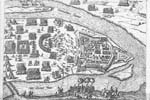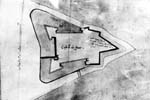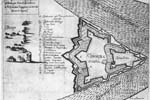|
Until the end of the Middle Ages the small
firearms had no particular importance as the
arrow of an English archer in the battle
went as far as the bullet of the firearm at
Waterloo and perhaps hit the target more
accurately though not with the same
efficiency. Although the field guns were at
the beginning of their development, the
heavy artillery guns had already made wide
cracks on the walls of the castles.

|
The French attacks against Italy between
1484-1493 proved that the fortress’
bastions built in the Middle Ages were
not able to withstand the more powerful
artillery.
By inventing the cannon, the basic
principles of the castle and fortress
building had changed all over the world.
In case of Komárno the necessity to
change became apparent in 1527 when the
armies of Ferdinand I besieged the
fortress. He occupied the fortress only
after a half-day siege and immediately
ensured the restoration of the destroyed
walls. He assigned the Italian architect
Decius to do it. The restoration work
was finished in 1528. In order to
protect the castle more efficiently,
ramparts were built between the town and
the fort. The extent of the renovation
of the castle by Ferdinand I is not
known, although in 1529 the Turkish
military expedition under the reign of
Suleiman II was able to invade the
fortress for a short period, since the
guards had left the fortress and the
Turkish army besieged the empty castle.
After recapturing the castle, Ferdinand
I had the damaged parts of the fortress
renovated; however in 1535 he was forced
to give the castle to the Turkish again.

|
After the invasion of Buda by the
Turkish troops, Emperor Ferdinand I was
forced to improve the fortification. He
got back the castle in 1544 and ordered
its extension. To prepare the plans of
the fortress, he assigned Pietro
Ferrabosco, who suggested a fort with
more angles.
This fortification system suited both
the contemporary architectural
aspirations and the configurations of
terrain and hydrography.
The contemporary fortress and castle
architects tried to find protection
against the heavy artillery by reducing
the walls of the forts and strengthening
them with earthen ramparts.
The year 1527 - when the first bastion
was built in Verona – is very important
for us because twenty years later, on
23rd March 1546, they started to build
the present Old Fortress in Komárno
based on the new experience in fortress
building. The building of the fort was
directed by Maria de Speciacasa and
later Dalmatio Bartolagi and the water
constructions by Mathias Dusco, Vencel
Cservenka and Paul Puls. The supervisors
of the constructions were Michael Schick
between 1546-1551, Leonhard Müller from
1550 and Francesco Begnino after 1552.
The fortification work was directed by
Domenico Castaldo in 1551. Emperor
Ferdinand I asked Castaldo to build the
eastern part of the fortress rapidly.
The supreme command decided during the
process of construction that for the
benefit of better defence of the town,
they would erect a palisade on the banks
of the rivers Vaag and Danube opposite
the fortress. However, the palisade,
which was able to hold 100-200 horsemen,
was constructed only in 1585.
The Old Fortress took ten years to
build. According to the reports of
Francesco Begnino in 1557, only the
earthen ramparts needed to be improved
and the water ditches deepened. The
plaque above the gate of the Old
Fortress with the year 1550 most
probably signifies the year when the
gate was made.
It is likely that the architects of the
fortress didn’t have enough experience
and knowledge about the quality of the
soil in the area as – according to the
report of the architect called Urban
Süess – in the spring of 1570 the flood
destroyed most of the walls. Under the
management of Urban Süess the fortress
was rebuilt between 1572 and 1592.
Famous experts from abroad such as
Daniel Speckle from Germany and Carlo
Theti from Italy also cooperated on
these projects. The new, improved and
rebuilt fortress stood the test in 1594
when Sinan pasha surrounded it with his
huge army and besieged the fortress for
a month but couldn’t capture it. We have
a precise ground plan from 1572, which
proves that the shape of the external
bulwark hasn’t changed since then. The
fortress, which extended from east to
west and was separated from the town by
water ditches, had five bastions.

|
Out of these five bastions, the eastern
bastion was the biggest; it served to
protect the confluence of the Vaag and
Danube Rivers. The main gate was located
on the west side of the fortress, near
the southwest bastion. The huge stone
walls of the fort emerged from the wide
and deep ditches. The earth taken from
the moat was used to build the external
entrenchments around the fort, which
protected the walls from cannons fired
on a flat trajectory. The cannons placed
on the protruding bastions (“Italian
bastions”) protected the moat, the side
and front wall of the adjoining bastions
as well as the walls between two
bastions.
After the Turkish military expedition in
1663-64 and because of the fall of the
forts in Nové Zámky, fortification
became important again. King Leopold I
ordred the building of two new forts.
One of them was Leopold Fort near
Galgóc; the other was the New Fortress
in Komárno.The fort which was named for
him was built in a very short time
between 1665-69. The New Fortress was
constructed between 1663-1673.
The thought of expanding the Old
Fortress was proposed earlier by Carlo
Theti, the famous architect, in 1570,
and he drew up two versions. However it
took quite a long time to complete it.
The first phase of the building process
ended in 1663. In this year the
entrenchments were built. Then the
entrenchments were rebuilt from stone
and brick. The works – based on the
plans of General Franz Wymes – were
accomplished using the most up-to-date
Italian and French work experience. The
New Fortress, which was built with great
ornateness, was completed in 1673,
according to the plaque above the main
gate. The western bastion and southern
parts were built from solid building
material, while the north wing was built
from earth.
The copper engraving prepared by
Bouttats Gaspar based on the plans of
Franz Wymes enables us to see what was
the fortification system like. This
engraving contains the list of some of
the parts of the fortification system in
Italian. According to this, the Old
Fortress remained in its original shape
as it was built in the 16th century.
Only the water ditches were deepened and
enlarged, dividing it from the New
Fortress. In front of the main gate of
the Old Fort, an irregular rampart was
erected with a broken entrance route
which protected the entrance of the
fortress. The New Fortress was built to
protect the Old Fortress. It was built
on a larger area than the old one, also
in the shape of a pentagon, and its two
eastern bastions were freely attached
to the two western bastions of the Old
Fortress behind the water ditches. Out
of the five bastions of the New
Fortress, the western bastion is the
largest – the middle one with its head
pointing towards the town. Both to the
north and south there were ramparts from
which the southern rampart with a
drawbridge had to protect the main gate
of the fortress. The gate was situated
in the middle of the fort wall between
the western and southern bastions. The
wide moat around the peripheral walls
followed the shape of the New Fortress.
There were casemates in the ramparts and
several gates for attacking the enemy.
At that time on the bulwarks around the
Old and New Fortress the peripheral side
of the ditches was built, the so-called
contraescarpment. Inside the earth
ramparts, in some places protected
routes and meeting places were formed.
Together with the other buildings in
Komárno the enormous fortress couldn’t
escape its fate and was badly damaged in
the flood in 1682. At the command of
Leopold I, a huge amount of money and a
regiment of soldiers (Dippenthal
regiment) was sent to Komárno to repair
the fortress. The renewed fortress
survived the last Turkish siege in 1683
when the soldiers of Imre Thököly,
allied with the Turkish troops, besieged
the fortress unsuccessfully. The Turkish
troops were defeated in the same year at
Vienna and after the war which lasted
sixteen years, Hungary was liberated
from the Turkish rule. It was a turning
point in the fortress’ life in that
Komárno also ceased to be a border town
and was not highly maintained. The
earthquakes in 1763 and 1783, the
epicentre of which were near the
fortress, destroyed it a great deal. As
the military management did not find it
important to restore the destroyed
fortress, the garrison of troops was
depleted. The sites on which the
fortress was located, were donated to
the town by Joseph II, and the buildings
were sold by auction in 1784. The
renovation of the fortress started again
in 1808 due to the Napoleonic wars.
|